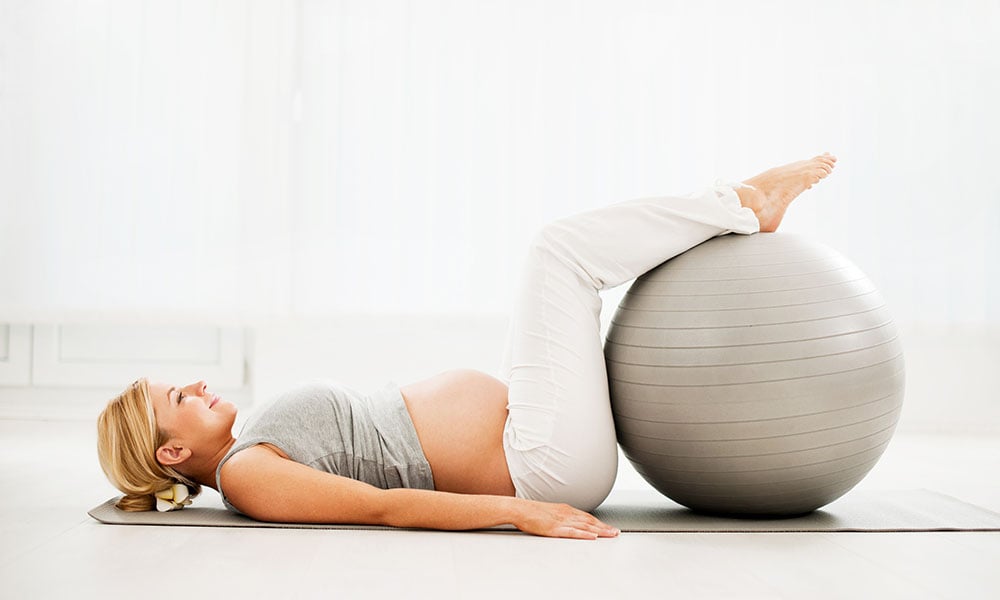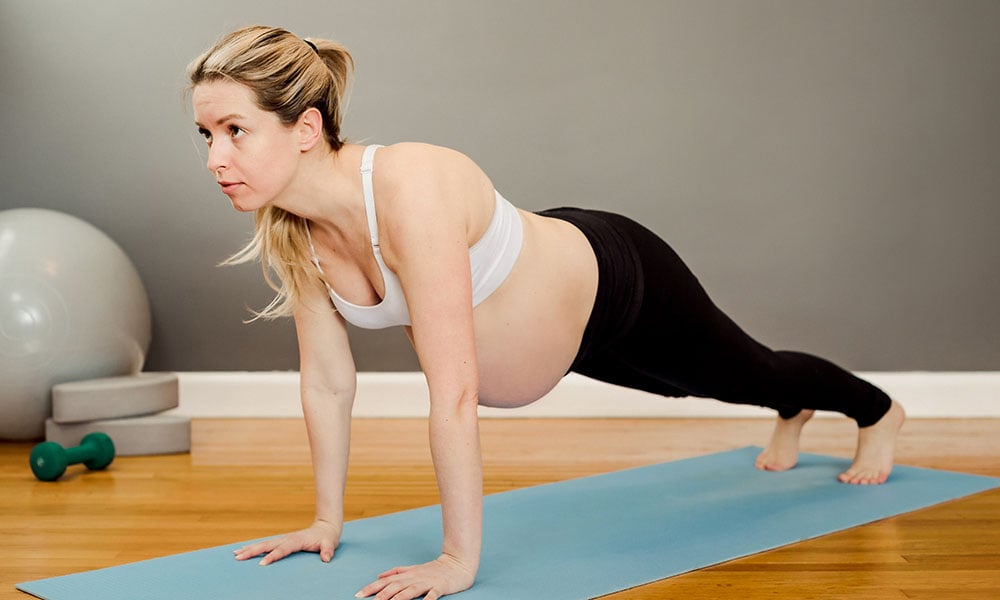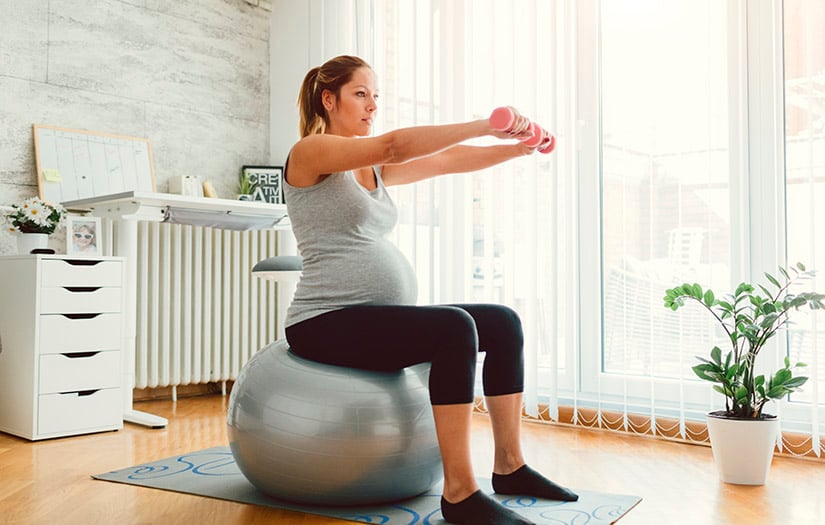Congratulations! You’ve begun your journey to motherhood (or perhaps adding to the family!) and are looking to make the most of the next nine months. While prepping for the nursery, you may be wondering what you can do to take care of yourself during this time.
According to the American College of Obstetricians and Gynecologists, 30 minutes of moderate exercise a day or 150 minutes of exercise a week during pregnancy is recommended. But what does this mean?
Here we will discuss the how, when, and why of exercise during pregnancy.
The content in this blog aligns with the NASM-WFS Course.
**Important Note: Before beginning any exercise while pregnant, there are a few things to keep in mind. Be sure to stay well hydrated while exercising, avoid exercising in hot or humid environments and always pay attention to how you feel. As always, consult your doctor before beginning any fitness routine.
Be sure to also check out this podcast on pre & postnatal fitness to learn more about the subject!
Cardio During Pregnancy

Walking
Walking is an excellent exercise that can be performed in each trimester. Walking with correct posture and at varying paces, from a brisk power walk in the first trimester to maybe a slightly slower stroll in the 3rd, provide various benefits every mother can benefit from.
Swimming
Swimming is considered a safe form of cardio during every trimester. Water provides support to joints and is an excellent form of cardiovascular exercise. Swimming also helps strengthen back, arm, and leg muscles helping you support your growing body on land.
Stationary Cycling/Ellipticals-
Using a stationary bike is generally considered a safe cardio option during pregnancy because there is a significantly lower risk of falling than bicycling. Other cardio machines like Ellipticals or Arc Trainers are also regarded as secure forms of cardio as they have a lower impact on the joints than running.
Prenatal Aerobics
Thanks to the internet, there are many different fitness classes available digitally. A low-impact prenatal aerobics program can be an excellent way to incorporate cardio into your fitness routine.
Strength Training During Pregnancy
Pushups
First-trimester standard pushups/knee pushups if you have been doing them regularly pre-pregnancy. In the second trimester, regress to wall pushups to lessen your core and back strain.
How to Perform a Wall Push Up

• Facing a wall, place your hands on the wall just outside of shoulder-width apart.
• While contracting your abs and holding your hips in a straight line with your head, shoulders, and ankles, slowly bend your elbows to lower your chest towards the wall.
• Stop when your elbows reach a 90-degree angle and reverse the motion to the starting position.
• Repeat.
Squats

Squats help strengthen the legs, glutes, core, and pelvic floor muscles essential during childbirth.
See also: Squats for Pregnant Women
How to Perform a Squat-
• Start with standing feet shoulder-width apart or slightly wider if it is more comfortable for your growing belly.
• With your hips in a neutral position, bend your knees and lower your body as if you are going to sit in a chair.
• Describe until your thighs are parallel to the floor, keeping your core engaged, pulling the belly button toward your spine.
• Pushing through your heels, stand back into your starting position. This is one rep. The squat can be performed by slowly lowering your body to a chair or bench and then progress to squatting without the chair or bench.
It is generally considered safe to continue barbell squats or weighted squats in the first trimester if you had been performing them pre-pregnancy.
Weightlifting During Pregnancy
If you have been weightlifting pre-pregnancy, it is generally okay to continue, modifying as your body changes.
Reducing weight used, omitting any exercises performed on your back, and listening to your body are integral in safely lifting weight while pregnant.
Stability Ball Exercises

The stability ball is an excellent piece of equipment to work into your prenatal fitness routine. The stability ball can be used alone or in conjunction with weights.
Sitting on the stability ball provides support while also making you engage core muscles to stabilize the ball. Simple arm exercises can be performed while sitting on a stability ball to increase arm strength and help strengthen core and back muscles.
Stability Ball Arm Curls
• Placing a stability ball on the floor, sit on the stability ball.
• Plant your feet firmly on the floor shoulder-width apart.
• With hips in a neutral position, sit up tall with your head over your chest and your chest stacked above your hips. Engage your core by pulling your belly button towards your spine.
• With a dumbbell in each hand, palms facing up. Slowly bring your hand toward your shoulder, bending at the elbow. Pause at the top and return to starting position. Repeat with the other hand.
Tricep Curls on Stability Ball
• Placing a stability ball on the floor, sit on the stability ball.
• Plant your feet firmly on the floor shoulder-width apart.
• With hips in a neutral position, sit up tall with your head over your chest and your chest stacked above your hips. Engage your core by pulling your belly button towards your spine.
With a light weight in one hand, raise your hand above your head, hand in a neutral position. Bending only at the elbow, lower your hand towards your back, extending your tricep, slowly return to starting position. This is one rep.
Core Exercises For Pregnancy
Core exercises definitely look a little different during pregnancy. After the first trimester, any exercises that you to lay on your back are out, so no crunches, sit ups, butterfly kicks or similar exercises. Some core require exercises to consider follow below.
See also: Progressive Exercises for Post Pregnancy
Stability Ball Pelvic Tilts
• Sitting on a stability ball with feet firmly planted on the floor sit with hips in a neutral position.
• While exhaling, slowly curl your hips forward, rounding your lower back. Make sure your are initiating the movement from your core and not your legs. Inhale and return to your starting position. Pelvic tilts safely help develop deep core muscles.
Stability Ball March
• Placing a stability ball on the floor, sit on the stability ball.
• Plant your feet firmly on the floor shoulder width apart.
• With hips in a neutral position, sit up tall with your head over your chest and your chest stacked above your hips. Engage your core by pulling your belly button towards your spine.
• While slowly exhaling, lift one foot off the ground, then lower it while exhaling. Repeat with other foot. This is one rep.
Planking and Pregnancy

Planking is considered safe in the first trimester of pregnancy. Moving into the second and third trimesters, planks can be modified to lessen the strain on the abdominal muscles.
In the second trimester, you can continue planking in with hands elevated on a bench and holding for short intervals, 5 to 10 seconds at a time. If you feel any strain in your abdominal muscles, bulging, or general discomfort, stop immediately.
Exercises to Relieve Back Pain
Lower back pain is a common complaint among pregnant women.
Strengthening the core, lower back, and glutes will help alleviate lower back pain. Squats, Pelvic tilts, stability ball marches can all help relieve lower back pain.
Prenatal Yoga

Prenatal yoga is an excellent way to keep moving during pregnancy. Prenatal yoga, hatha yoga, and restorative yoga practices are best for pregnant women. Hot yoga is not considered safe for pregnant women and should be avoided.
Speak to your instructor about any modifications you may need. Avoid any inversions, big bends, and any positions on your back. While doing yoga, pay attention to how you are feeling and always stop or modify any position if you feel strain.
Exercises to Avoid During Pregnancy
Per the American College of Obstetrics and Gynecology, some exercises to avoid include any contact sport or sport where you may be hit in the abdomen, sky diving, any exercise where there is a risk of falling, or scuba diving.
Additionally, once you reach the second trimester, it is essential to avoid any exercise that requires you to lay on your back. As the uterus grows, it can block blood flow to vital organs while laying on your back.
Why exercise during Pregnancy?
Women who exercised regularly during pregnancy reduce their risk of developing gestational diabetes by 50% and reduce their risk of developing pre-eclampsia by almost 40%. Additionally, even moderate exercise reduced the risk of gestational diabetes by 30%. (Di Paolo et al., 2019). Exercising during pregnancy can also improve general fitness and recovery during the post-partum period. (ACOG 2019)
Pregnancy is an exciting time in every women’s life, and it is an excellent time for Mom to focus on herself before the baby arrives. Not only does getting regular exercise benefit Mom’s health physically, but endorphins released during pregnancy can also help boost Mom’s mood and reduce stress.
Conclusion
There are so many physical changes with pregnancy it can be intimidating to figure out where to start. As long you have been medically cleared by your doctor, you can continue your current exercise regimen during the first trimester.
As your pregnancy progresses, you may have to modify or regress some exercises to accommodate your pregnancy. Not regularly exercising currently? No worries, there are plenty of ways to begin exercising safely. Should you train for a marathon or pick up Olympic weightlifting? Maybe not, but there are many other options - as this blog has shown you.
Sources
Artal, R. (2003). Guidelines of the American College of Obstetricians and Gynecologists for exercise during pregnancy and the postpartum period. British Journal of Sports Medicine, 37(1), 6–12. https://doi.org/10.1136/bjsm.37.1.6
Exercise During Pregnancy. ACOG. (2019). https://www.acog.org/womens-health/faqs/exercise-during-pregnancy.
Davenport, M. (n.d.). Impact of prenatal exercise on neonatal and childhood outcomes: a systematic review and meta-analysis. https://bjsm.bmj.com/content/52/21/1386.
Juhl, M., Kogevinas, M., Andersen, P. K., Andersen, A.-M. N., & Olsen, J. (2010). Is Swimming During Pregnancy a Safe Exercise? Epidemiology, 21(2), 253–258. https://doi.org/10.1097/ede.0b013e3181cb6267
Paolo, J. D., Montpetit-Huynh, S., & Vopni, K. (2019). Pregnancy fitness. Human Kinetics.
Szumilewicz, A., & Santos-Rocha, R. (2019). Exercise Selection and Adaptations During Pregnancy. Exercise and Sporting Activity During Pregnancy, 231–308. https://doi.org/10.1007/978-3-319-91032-1_9

















